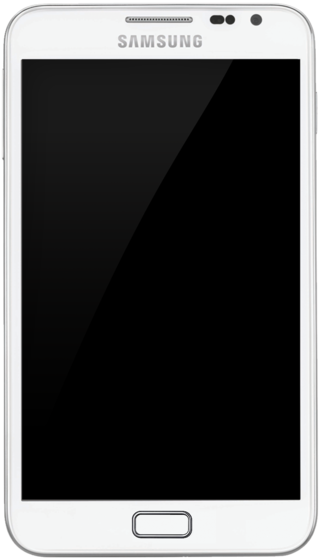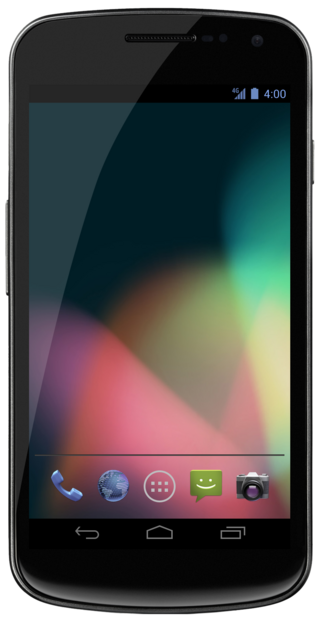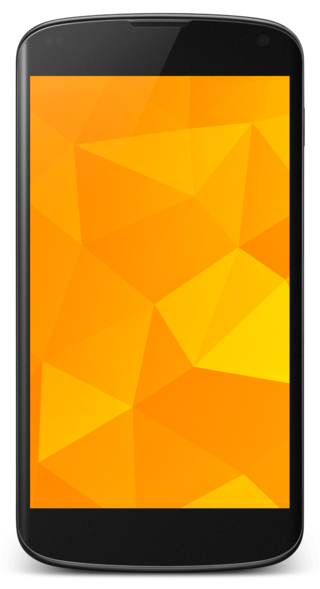Google Nexus is a discontinued line of consumer electronic devices that run the Android operating system. Google managed the design, development, marketing, and support of these devices, but some development and all manufacturing were carried out by partnering with original equipment manufacturers (OEMs). Alongside the main smartphone products, the line also included tablet computers and streaming media players; the Nexus started out in January 2010 and reached its end in October 2016, replaced by Google Pixel.

The Samsung Galaxy Tab 7.0 or simply Samsung Galaxy Tab is an Android-based mini-tablet computer produced by Samsung. Available from 5 November 2010. The tablet was first introduced on 2 September 2010 at the IFA in Berlin. The Galaxy Tab was the first Samsung Android-powered tablet to be released.

The Nexus S 4G is a smartphone co-developed by Google and Samsung and manufactured by Samsung Electronics for release in 2010. It was the first smartphone to use the Android 2.3 "Gingerbread" operating system, and the first Android device to support Near Field Communication (NFC) in both hardware and software.

A Chromebook is a laptop or tablet running the Linux-based ChromeOS as its operating system. Initially designed to rely heavily on web applications for tasks using the Google Chrome browser, Chromebooks have since expanded to be able to run Android and full-fledged Linux apps since 2017 and 2018, respectively. All supported apps can be installed and launched alongside each other.

The Samsung Galaxy Note is an Android smartphone produced by Samsung Electronics. Unveiled at IFA Berlin 2011, it was first released in Germany in late October 2011, with other countries following afterwards. The Galaxy Note was distinguished by its unusually large form factor—later referred to using the term "phablet"—which straddled the size of the average smartphone at the time, and that of a small tablet: it features a 5.3-inch display, and is bundled with a stylus branded as the "S Pen", which can be used to navigate the device's user interface, and write or draw in supported apps.

The Barnes & Noble Nook is a brand of e-readers developed by American book retailer Barnes & Noble, based on the Android platform. The original device was announced in the U.S. in October 2009, and was released the next month. The original Nook had a six-inch E-paper display and a separate, smaller color touchscreen that serves as the primary input device and was capable of Wi-Fi and AT&T 3G wireless connectivity. The original Nook was followed in November 2010 by a color LCD device called the Nook Color, in June 2011 by the Nook Simple Touch, and in November 2011 and February 2012 by the Nook Tablet. On April 30, 2012, Barnes & Noble entered into a partnership with Microsoft that spun off the Nook and college businesses into a subsidiary. On August 28, 2012, Barnes and Noble announced partnerships with retailers in the UK, which began offering the Nook digital products in October 2012. In December 2014, B&N purchased Microsoft's Nook shares, ending the partnership.

The Amazon Fire, formerly called the Kindle Fire, is a line of tablet computers developed by Amazon. Built with Quanta Computer, the Kindle Fire was first released in November 2011, featuring a color 7-inch multi-touch display with IPS technology and running on Fire OS, an Android-based operating system. The Kindle Fire HD followed in September 2012, and the Kindle Fire HDX in September 2013. In September 2014, when the fourth generation was introduced, the name "Kindle" was dropped. In later generations, the Fire tablet is also able to convert into a Smart speaker turning on the "Show Mode" options, which the primary interaction will be by voice command through Alexa.

The Galaxy Nexus (GT-I9250) is a touchscreen Android smartphone co-developed by Google and Samsung Electronics. It is the third smartphone in the Google Nexus series, a family of Android consumer devices built by an original equipment manufacturer partner. The phone is the successor to Google's previous flagship phones, the Nexus One and Nexus S.

The first-generation Nexus 7 is a mini tablet computer co-developed by Google and Asus that runs the Android operating system. It is the first tablet in the Google Nexus series of Android consumer devices marketed by Google and built by an original equipment manufacturer partner. The Nexus 7 features a 7.0-inch (180 mm) display, an Nvidia Tegra 3 quad-core chip, 1 GB of RAM, Wi-Fi and NFC connectivity, and 8, 16 or 32 GB of storage. The tablet was the first device to ship with version 4.1 of Android, nicknamed "Jelly Bean". By emphasizing the integration of the Google Play multimedia store with Android 4.1, Google intended to market the Nexus 7 as an entertainment device and a platform for consuming e-books, television shows, films, games, and music.

The Samsung Galaxy Tab 2 7.0 is a 7-inch Android tablet produced and marketed by Samsung Electronics. Samsung Galaxy Tab 2 is an Ice Cream Sandwich sequel. It belongs to the second generation of the Samsung Galaxy Tab series, which also includes a 10.1-inch model, the Galaxy Tab 2 10.1. It was announced on 13 February 2012, and launched in the US on 22 April 2012. It is the successor to the Samsung Galaxy Tab 7.0 Plus.

The Nexus 4 is an Android smartphone co-developed by Google and LG Electronics. It is the fourth smartphone in the Google Nexus product family, unveiled on October 29, 2012, and released on November 13, 2012, and succeeded the Samsung-manufactured Galaxy Nexus. As with other Nexus devices, the Nexus 4 was sold unlocked through Google Play, but was also retailed by wireless carriers.
Google Pixel is a brand of portable consumer electronic devices developed by Google that run either ChromeOS or the Android operating system. The main line of Pixel products consist of Android-powered smartphones, which have been produced since October 2016 as the replacement of the older Nexus, and of which the Pixel 7 is the current model. The Pixel brand also includes laptop and tablet computers, as well as several accessories, and was originally introduced in February 2013 with the Chromebook Pixel.

The second-generation Nexus 7, also commonly referred to as the Nexus 7 (2013), is a mini tablet computer co-developed by Google and Asus that runs the Android operating system. It is the second of three tablets in the Google Nexus tablet series, the Nexus family including both phones and tablets running essentially stock Android which were originally marketed for developer testing but later marketed by Google to consumers as well, all of which were built by various original equipment manufacturer partners. Following the success of the original Nexus 7, this second generation of the device was released on July 26, 2013, four days earlier than the originally scheduled date due to early releases from various retailers. The tablet was the first device to ship with Android 4.3.

The Samsung Galaxy Tab 3 7.0 is a 7-inch Android-based tablet computer produced and marketed by Samsung Electronics. It belongs to the third generation of the Samsung Galaxy Tab series, which also includes the 8-inch Galaxy Tab 3 8.0 and the 10.1-inch Galaxy Tab 3 10.1. It was announced on 29 April 2013 and launched in the US on 7 July 2013.

The following is a comparative list of smartphones belonging to the Google Nexus line of devices, using the Android operating system.

The Nexus 9 is a tablet computer co-developed by Google and HTC that runs the Android operating system. It is the fourth tablet in the Google Nexus series, a family of Android consumer devices marketed by Google and built by an OEM partner. The device is available in two storage sizes, 16 GB for US$399 and 32 GB for US$479. Along with the Nexus 6 mobile phone and Nexus Player digital media device, the Nexus 9 launched with 5.0 Lollipop, which offered several new features, notably a modified visual appearance, and the complete replacement of the Dalvik virtual machine with ART. Google has included an additional step to "Enable OEM unlock" before users can unlock the Nexus 9 bootloader.

Nexus 6P is an Android smartphone developed and marketed by Google and manufactured by Huawei. It succeeded the Nexus 6 as the flagship device of the Nexus line of Android devices by Google. Officially unveiled on 29 September 2015 along with the Nexus 5X at the Google Nexus 2015 press event held in San Francisco, it was made available for pre-order on the same day in United States, United Kingdom, Ireland, and Japan.

The Pixel C is a 10.2-inch (260 mm) Android tablet developed and marketed by Google. The device was unveiled during a media event on September 29, 2015. On October 9, 2018, it was succeeded by the Pixel Slate.
The Huawei Mate series is a line of high-end HarmonyOS-powered phablet smartphones produced by Huawei, and is one of the flagship smartphones along with the P series. Under the company's current hardware release cadence, P series phones are typically directed towards mainstream consumers as the company's flagship smartphones, refining and expanding upon technologies introduced in Mate series devices. Since 2016, Huawei has been in a co-engineering partnership with the German manufacturer Leica, whose lenses have subsequently been used on the Mate series.

The Samsung Galaxy Tab S4 is a tablet computer developed and produced by Samsung Electronics. It is the successor of the previous Galaxy Tab S3, and was announced alongside the cheaper Samsung Galaxy Tab A 10.5.

















